Today marks two weeks of run-in time for the new Duelund CAST tinned-copper crossovers in the "Stokowski" Altec's.

Duelund CAST Sn-Cu crossover for the right "Stokowski" Altec loudspeaker.
I've been running the Seattle Jazz24 stream whenever there's not an LP spinning on my CTC Garrard 301. If you love jazz be sure to check out Jazz24. The Jazz24 stream sounds great, plays 24/7, has a great selection of jazz, and is free (although they'd love to get a donation from you to keep the jazz playing - I donate to Jazz24 using Amazon Smile).

CTC Garrard 301 turntable.
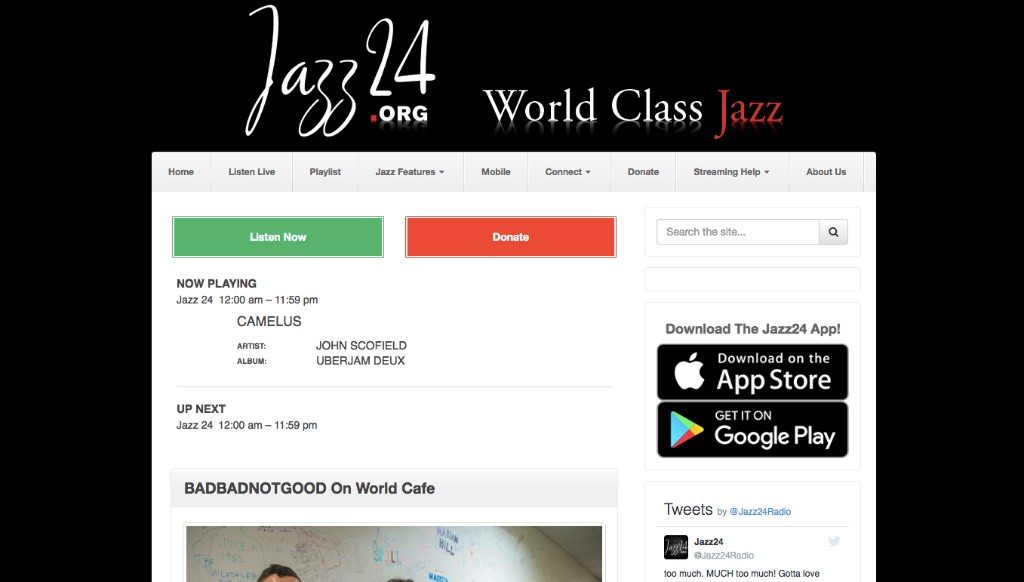
Jazz24
Over the last week I've continued to get about 6 to 8 hours of run-in time per day on the Duelund CAST Sn-Cu crossovers, so they should have somewhere between 84 to 112 hours on them now.

New Duelund CAST Sn-Cu crossovers in the left "Stokowski" Altec loudspeaker.
This last week brought about more changes in the Duelund CAST Sn-Cu crossovers than I was expecting during the run-in process.
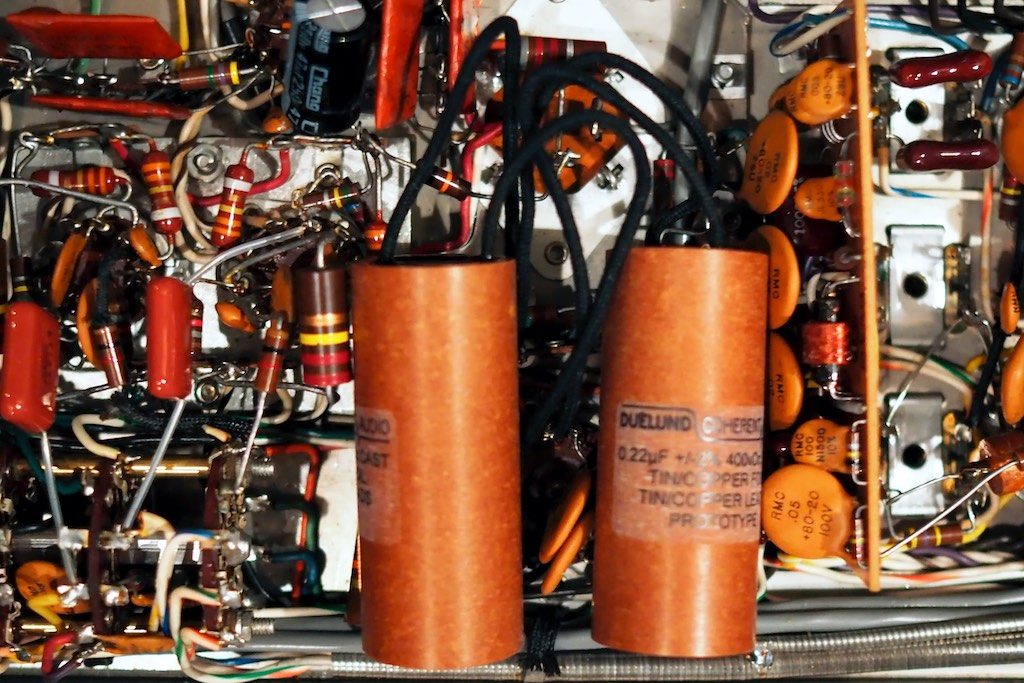
A pair of prototype 0.22uF Duelund CAST Sn-Cu capacitors that I've soldered into my vintage MX110Z McIntosh tuner-preamplifier.
When, for example, I tried the prototype 0.22uF Duelund CAST tinned-copper capacitors in the cathode follower of my MX110 preamp in November 2016 I conditioned them for 6 hours on my Cable Cooker, and I didn't really hear that much change in them over time after that.
I found that it was very apparent that the 0.22uF Duelund CAST Sn-Cu capacitors were in a league of their own compared to any other capacitors I have tried in my vintage McIntosh MX110Z tuner-preamplifier, and I said that they had"... extremely vivid tone color, superb dynamic response, melodic sophistication, harmonic complexity, live-like timbral complexity, spooky imaging presence, natural live-like level of resolution, generous portrayal of soundstage & soundspace, a presentation so breathtakingly musical, and with such high level of intensity of emotional engagement that I'm positively giddy about it.".
Somehow I had forgotten that I had done 6 hours of conditioning on the prototype caps with my Cable Cooker (which is why I didn't hear much change in their performance over time), so I didn't do any on the Duelund CAST Sn-Cu components in the "Stokowski" Altec crossovers.
That's probably a good thing, as now I can say a little more about how their sound changes throughout the run-in process.
Last week I said, "The Duelund CAST tinned-copper crossovers have a beguiling relaxed clarity about them that I find very appealing ... Initially I was hearing a little roughness in the upper-midrange, which I suspected was due to the Duelund DCA16GA tinned-copper wiring in the crossover needing a little run-in time, as the DCA16GA can sound a little rough until it runs-in. In listening to The Harrow & The Harvest just now, that little bit of upper-midrange roughness has diminished by a little more than half, so it appears my speculation about the DCA16GA was on target, and everything is smoothing out nicely as it runs-in."
The changes I heard in that first week's 42 to 56 hours of run-in time were relatively subtle compared to what I heard as they worked their way towards the 84 to 112 hours mark in the second week of listening.
In that first week of listening I had attributed most of the change that I was hearing to the run-in process of the Duelund DCA16GA tinned-copper wire that I used for point-to-point wiring, but what I heard this week was atypical of what occurs during the DCA16GA run-in process, so it's more likely that this week I was hearing a greater contribution from the changes in the Duelund CAST Sn-Cu capacitors and inductors during the run-in process.
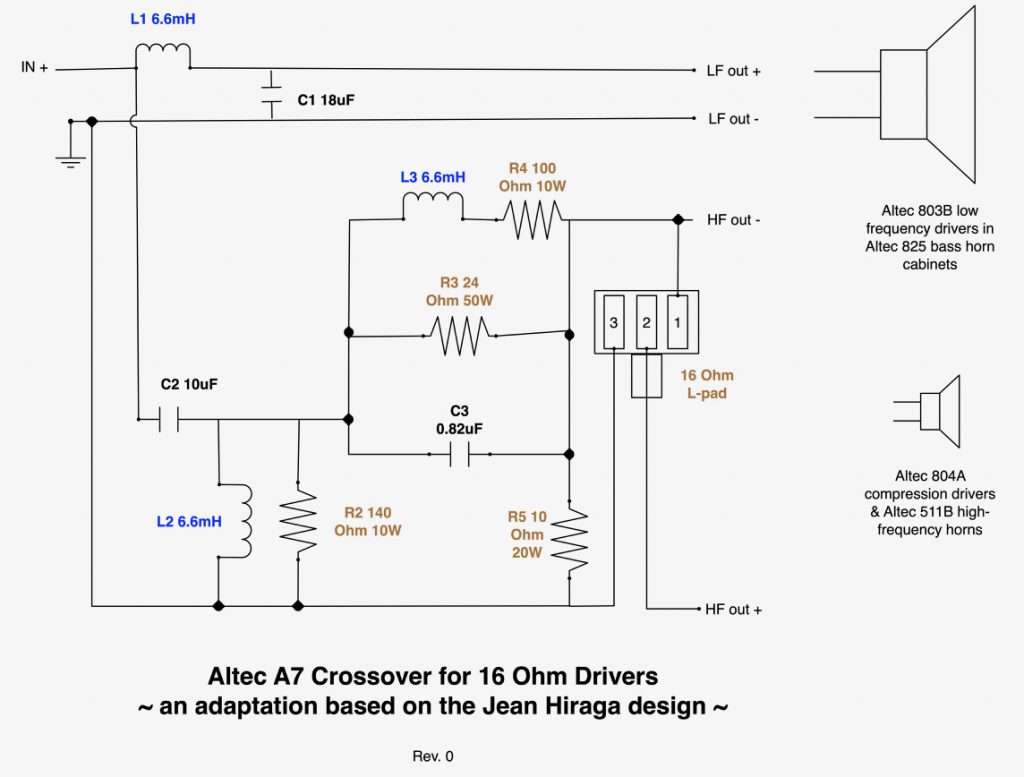
As a refresher, to build a pair of the Hiraga-inspired crossovers for the "Stokowski" Altec loudspeakers the following Duelund CAST Sn-Cu components were used:
- Six 6.6mH inductors for L1, L2, and L3.
- Two 18uF capacitors for C1.
- Two 10uF capacitors for C2.
- Two 0.82uF capacitors for C3.
- Two 140 Ohm 10W resistors for R2.
- Two 24 Ohm 50W resistors for R3.
- Two 100 Ohm 10W resistors for R4.
- Two 10 Ohm 20W resistors for R5.
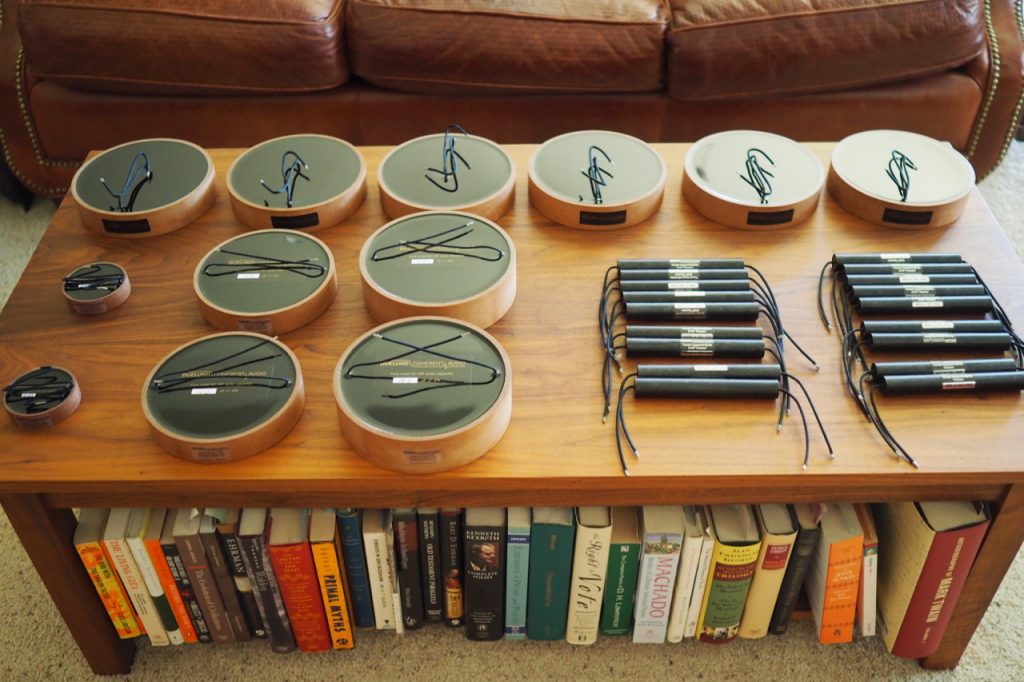
That's a lot of tinned-copper in those Duelund CAST Sn-Cu capacitors and inductors to run-in!
Low-frequency circuit performance (500 Hz crossover point and below)
Let's start with the LF circuit for the Altec 803B low-frequency drivers first. As the four 6.6mH inductors for L2 and L3, and the two 10uF capacitors for C2 and the two 0.82uF capacitors for C3, got more run-in time on them the sound of the low-frequencies changed rather dramatically, which I wasn't really expecting.
After the first week of run-in I would have generally described the low-frequency performance as having a relaxed transparency with superb beat and dynamics. Well, it turns out that after two weeks there was a rather dramatic improvement in transparency in the low-frequencies, making the first week's low-frequency performance seem almost murky in comparison.
If you had told me that what I was hearing last week in the low-frequencies was "murky" I would have laughed at you, and pointed out the high clarity, with lots of natural sounding details, the beat prowess, and a really nice separation of instruments upon the soundstage.
What a difference a week makes!
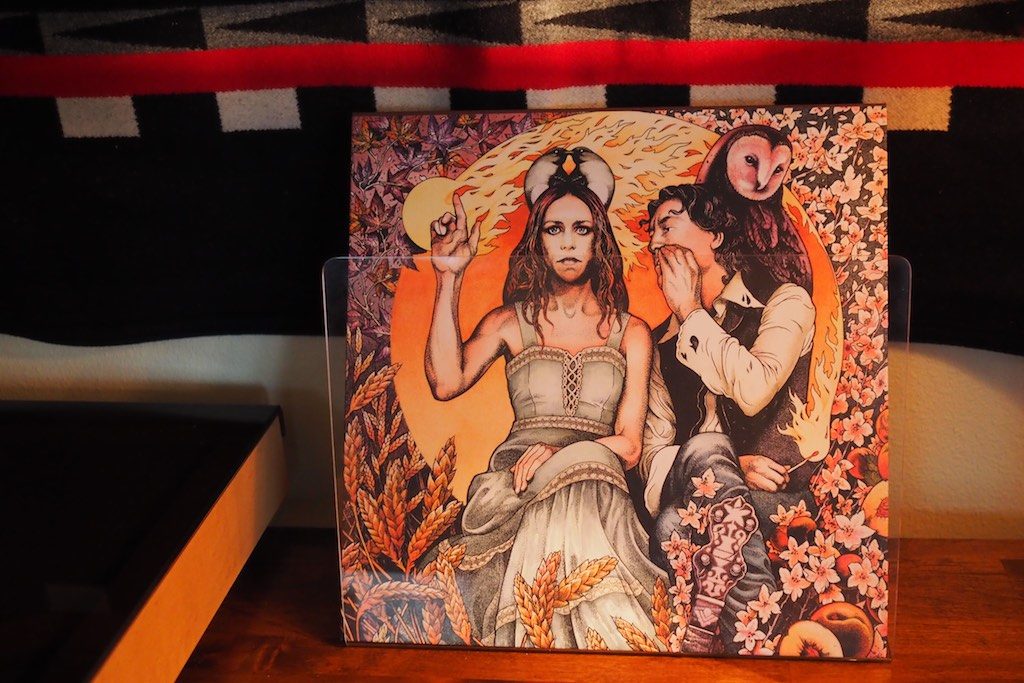
The Harrow & The Harvest
Taking again The Harrow & The Harvest album by Gillian Welch and David Rawlings as an example, the lowest note on the standard guitar is the 6th E string at 82.41 Hz, which is well below the 500 Hz crossover point of the crossover, and ranges up to about 1200 Hz high up the 1st E string (although harmonics will give you even higher frequencies than that), which is well above the 500 Hz crossover point.
Well, over the course of the last week the low-frequencies gained a considerable dose of clarity, with more resolution of string tone evident, both in David's crosspicking, and in Gillian's rhythm playing.
In particular, the individual contributions of each string/note in Gillian's rhythm playing became much more apparent with the increased run-in time, and there was more of sense of reverberant space around the low-frequency tones. Both Gillian's and David's guitars also showed more resolution of subtle harmonic detail and timbral textures, yet still with a relaxed clarity that made everything sound natural and not etched or unrealistic in terms of fidelity.
High-frequency circuit performance (500 Hz crossover point and above)
The changes in the high-frequency circuit were similar, with more clarity, more resolution of string tone, more resolution of Gillian's and David's harmonies.
I did notice that the little bit of upper-midrange roughness I was hearing has remained to a degree, but has continued to smooth out. Where I hear this "roughness" is primarily with Gillian's vocals when she really leans into it dynamically, which occurs on a couple of the albums songs, but not on others.
All Together Now
Overall, what I'm hearing from the Duelund CAST Sn-Cu crossovers in the "Stokowski" Altec loudspeakers is "... extremely vivid tone color, superb dynamic response, melodic sophistication, harmonic complexity, live-like timbral complexity, spooky imaging presence, natural live-like level of resolution, generous portrayal of soundstage & soundspace, a presentation so breathtakingly musical, and with such high level of intensity of emotional engagement that I'm positively giddy about it," which is how I described my impressions of the prototype Duelund CAST Sn-Cu capacitors in my MX110 preamp.
I really, really, like what I'm hearing from the Duelund CAST Sn-Cu components in the "Stokowski" Altec's, and I think they are a major breakthrough in performance, just as the prototype Duelund CAST Sn-Cu capacitors were in my MX110 before them.
There's a couple of other things I noticed as the crossovers got some more run-in time on them, the first being that the ability to play naturally at louder SPLs improved considerably, and secondly the amount of adjustment of the L-pads needed to get a pleasing high-frequency to low-frequency balance changed quite a lot as well.
Loudness Levels
For example, during the first week of run-in about 10 o'clock or so on the Spec amp's volume control was the upper-end of what sounded musically natural, and above that things started to get a little bit disheveled.
Now, with another week of run-in time, the volume control can be at just a few ticks before 12 o'clock and still sound musically natural, which represents the low to mid 90 dB's peaks at the listening seat, and puts a lot of the musical content in the mid-seventies to mid-eighties SPLs during listening.
For live-like listening levels, I normally consider 92db to 96db to be largely representative of live-performance loudness levels, which is a loudness range that a lot of sound reinforcement tech's like to set sound levels for live performances.
High-Frequency to Low-Frequency Balance
Another aspect of performance that changed quite a lot over the last week was where the L-pad could be set to achieve a natural sounding high-frequency to low-frequency balance.
I tend to like less high-frequency prominence in loudspeaker voicing than a lot of contemporary loudspeakers have, and that a lot of listeners seem to like.
If the high-frequencies tend to call attention to themselves overtly, that tends to put me off, as I like a more natural presentation of high-frequencies that is more like you hear in life (not exaggerated to grab a listener's attention).
I haven't yet measured the actual resistance of the L-pad at the various settings I've tried, so I'm just going by rough position marks on the L-pad itself at this point in time.
Over the weekend I had Ron, Leo, and Dana over for a hifi afternoon of fun & games, and I tried out several different L-pad settings on them so I could hear their impressions.
My L-pads settings are 3, 2, 1, 0, -1, -2, and -3, with 3 being the most resistance and -3 being the least resistance. The numerical values don't have any relationship to actual resistance values, rather they are just numbers I wrote down on the L-pad that span the L-pad's range of resistance.
During the first week of run-in, the range of L-pad settings I preferred across various albums was around positions 2 to 1. If I got above 1 I thought the high-frequency balance became a little too prominent.
During our little hifi listening session I used settings 2, 1, and 0, for Leo, Ron, and Dana to listen to and comment on, and they preferred the zero setting, which makes for a greater high-frequency to low-frequency balance than I had preferred earlier.
Now, with another week of run-in time, my favored frequency balance had also shifted from 2 or 1 on the L-pad to 0, or even -1, but most of the time I prefer the zero setting, as did Dana, Leo, and Ron. That's pretty good consensus across four listeners.
I think the improvement in performance that the additional run-in has wrought on the Duelund CAST Sn-Cu components - particularly in the HF crossover circuit - is responsible for this shift.
The Path Forward
I've been debating on how to proceed with the Duelund-Altec Project crossovers, but I think I'm going to exercise some patience and see what happens after another week or two of run-in time.
If after another week of run-in time I'm still hearing significant changes in performance, then I'll go for another week or so of run-in time and listen to the result.
When the Duelund CAST Sn-Cu components plateau in their run-in time to a stable sound presentation, I think I'll then give them some run-in time on my Cable Cooker and see if that yields additional changes.
My buddy Ron is going to install a rebuilt MX110 volume pot for me in the near future (rebuild courtesy of of Audio Classics who offers a $120 USD rebuild service for no longer available potentiometers), and at that point I'll give my vintage MX110 preamp and MC30 monaural amplifiers a listen in the system as well.
After that then I'll starting thinking about any voicing that needs to take place to dial in the crossovers' final performance.
Ok, that's it for now, and as always, thanks for stopping by, and may the tone be with you!



























